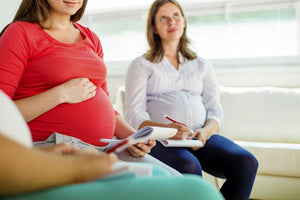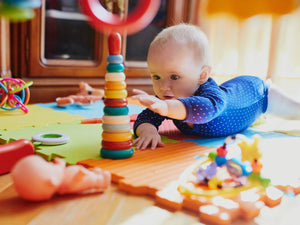Birth plans help expectant parents to have a sense of control over the way their baby is born. They also assist maternity care providers to understand more clearly what is important to a mother when she’s in labour and birthing her baby. While birth plans are not compulsory it can be helpful to have one written up well before a baby’s due date.
What is a birth plan?
A birth plan is a written record of how you’d like to be supported in labour and when you’re having your baby. How much detail you go into is entirely your choice – some expectant parents prefer to have a very comprehensive plan covering every possibility, others just bullet point what’s really important to them.
Essentially birth plans are a form of communication between a mother, partner and maternity care provider.
There are no right or wrong ways to write up a birth plan; it also pays not to compare your birth plan with someone else's.
Why would I want to have a birth plan?
A birth plan is useful because it relies on some insights into labouring, birth and the early moments after a baby is born. It’s helpful for most expectant parents to have some understanding of what’s involved and even if a birth plan isn’t finalised, looking into choices is always worthwhile.
Some women prefer to have a greater sense of control than others over their labour and baby’s birth. Often, a woman and her partner write up the birth plan together so they can include what’s mutually important.
What do I need to include in my birth plan?
You could use a template as a prompt for what to include. Alternately, you could develop your own birth plan which is unique to you. Either way, your birth plan will need to include:
- Information which is unique to your wishes and allows for safety and the unexpected.
- Who you would like for support, including your partner and/or a birth companion or doula. Currently, COVID restrictions are impacting on maternity care and it is useful to check current guidelines.
A clear birth plan will include:
- What’s most important to you at the top of the plan.
- Where you will be having your baby. Every maternity hospital has their policies and procedures.
- The frequency, timing and need for checks when you’re in labour.
- If you would prefer your birth to be as ‘natural’ as possible and not be induced or have other interventions.
- If you’d like to labour in water, for example in the shower or the bath. And if this is an option, if you’d like to have a water birth.
- The type of pain relief you would like.
- A list of medical interventions which you may prefer e.g., artificial rupture of membranes, fetal monitoring, episiotomy (or to tear naturally), use of forceps or vacuum extraction if needed.
- The position you’d like to be in when labouring and birthing your baby.
- Your preferences for skin-to-skin contact.
- If you would like delayed cord clamping and your preferences around what you’d like done to the placenta e.g., bring it home.
- If you’re planning to breastfeed and when you’d like to offer your baby their first feed.
- Any culturally important factors of importance.
- Ways your birthing partner can provide support and if necessary, advocate for you.
Top 10 tips when writing up a birth plan
- Focus on what’s important – that you and your baby are safe and well during your labour and after birth.
- Expect to make some changes in your plan as you approach your baby’s due date. What can seem very important in the first and second trimesters may be less so in your third.
- Don’t view your birth plan as a guarantee of what will happen. Allow for the unexpected when having your baby, which might include an unplanned but necessary caesarian section.
- Remember, there’s your baby to consider as well. They can’t have a voice so will rely on you and your maternity care provider to advocate for them.
- Speak with your maternity care provider. They are in a position to give you insights into what could be valuable to include and what may not be possible for you. For example, if you have a placenta praevia, a vaginal birth may not be possible.
- Write the plan together with your partner or birth support person and include ways they can support you in labour. The time to plan for this is in your pregnancy and ideally not when you’re already in labour.
- Speak with close friends and family who’ve had children and whose insights you respect. They may have some ideas you’ve not considered.
- Avoid thinking your birth plan is a guarantee of what will happen. There are all sorts of influencing factors when it comes to labour and birth, many of them unpredictable.
- Remember, birth plans are not a ‘pass or fail’ process. They’re intended to be a summarised guide for what’s important to you when you’re having your baby.
- If possible, go to or enrol in some form of antenatal education so you’ll have a good understanding of the labour and birth process.
About the Author:
Written for Nourish Baby by Jane Barry. Jane has qualifications in general, paediatric, immunisation, midwifery and child health nursing. She holds a Bachelor Degree in Applied Science (Nursing) and has almost 35 years specialist experience in child health nursing. She is a member of a number of professionally affiliated organisations including AHPRA, The Australasian Medical Writer’s Association and Australian College of Children and Young People’s Nurses.
References
Developing a birth plan - Better Health Channel
https://www.pregnancybirthbaby.org.au/making-a-birth-plan
Preparing for labour | The Royal Women's Hospital (thewomens.org.au)
Our Products
-

01. Guide to a Healthy Pregnancy
$55 -

02. Positive Birthing Course
$55 -

03. Infant Feeding Guide
$55 -

04. Baby Sleep Guide - First 12 Months
$55 -

05. Toddler Parenting Course 1 - 3 Years
$55
-
 When to Start Antenatal Classes?
When to Start Antenatal Classes?
Becoming a parent is an incredible milestone, but it comes with a host of changes that can be daunting, especially for first time parents. Antenatal classes are all about offering expectant parents the education they need to make informed decisions, look after their bodies and care for their newborn babies. While you probably already have a long list of things you need to accomplish during your pregnancy, it’s a good idea to make time to attend antenatal classes.
-
 Development Milestones 4-8 Months
Development Milestones 4-8 Months
As they reach the middle of their first year, you'll start to see bigger leaps in their growth and ability!
In this article, we’re going to discuss your baby’s developmental milestones between 4-8 months, and what you can expect along the way.





 When to Start Antenatal Classes?
When to Start Antenatal Classes?
 Development Milestones 4-8 Months
Development Milestones 4-8 Months








